How to care for a croton at home
Among decorative-deciduous houseplants, croton can be safely called one of the most striking. But the trouble is that even with very careful care, this flower at home very quickly loses its attractiveness, and eventually dies. Learn how to properly care for a moody plant and what its owner needs to know in this review.
Botanical description of the plant
Croton (Latin name Codiaeum) is a perennial evergreen plant of the family Euphorbiaceae. It is found in nature in the tropical and subtropical forests of Australia, Oceania (Polynesia), India, and also some islands of Southeast Asia (Malaysia, the Philippines, etc.). Due to the amazing coloring of the leaves, the flower is sometimes popularly called the "Cloak of Joseph."
Did you know? Kodiyeum is the original name of the plant, probably coined by its discoverer, the Dutchman Georg Rumfius, who studied orchids on Ambon Island in Indonesia in 1654 and saw an original shrub there. Locals called the perennial the beautiful word "kodibo", although today "kodiyeum" is rather associated with the Greek "codeia", which means "head". Despite the fact that the plant came to Europe in the second half of the seventeenth century, the real fashion for it began only three hundred years later. Together with Dieffenbachia and Drazen, croton was initially grown by florists from the Netherlands, and from there it began to conquer the world.
Describing the botanical features of codium, it is necessary to highlight the following basic characteristics of the plant:
| Maximum sizes | 50-150 cm (in the wild - up to 300 cm) |
| Root system | Powerful, fast growing |
| The stalks | Dense, erect, with a large number of lateral processes |
| Leaves | Petioles. The structure is dense and leathery, with a beautiful gloss. The sizes are large (up to 30 cm in length). The shape can be different (lanceolate, three-fingered, oval, lobed, carved, spiral, often flat, but sometimes with wavy edges). A distinctive feature is a bright and bizarre color: against the main background of any shades of green, stains, streaks, stripes, splashes and other fragments of yellow, white, purple, pink and other contrasting or nuanced colors can be found |
| Inflorescence | Pistiform (panicle) |
| Flowers | Small, devoid of decorativeness, white, yellow or beige with long anthers protruding forward |
| Fruit | Large seed box |
Important! Like other Euphorbiaceae, codium is poisonous. Such a flower is not advisable to keep people with pets (especially cats). Also, croton juice can cause serious irritation on the skin, so pruning and transplanting the plant must be carried out with protective gloves. An interesting botanical feature of codium is the ability to change the color and shape of leaves depending on environmental conditions. It is on this amazing property that active breeding work aimed at breeding new varieties of decorative flower is based.
Kinds
The genus Sodiaeum includes more than a thousand different plants, and it includes not only shrubs, but also trees. However, only one variety of croton is used as a room flower - Codiaeum variegatum, or variegated codium. In turn, inside this species there are a huge number of different varieties and hybrids, including those bred by breeding. From each other, they differ in the shape, size and color of the leaves.
Read more about the types of croton.
So, in flower shops today you can buy the following varieties of croton:
- narrow-leaved (Angustifolium): leaves have a pointed shape, do not exceed 15 mm in width, color - golden spots on a green background;

- appendage (Appendiculatum): the leaves are oval, but in the middle part they have a narrowing, as if drawn by a belt;
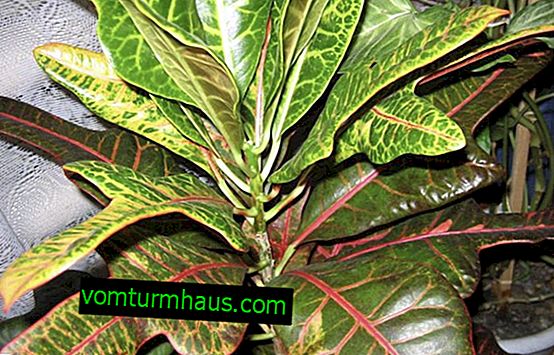
- curly (Сrispum): leaves are narrow and wavy, very bright colors;

- Mrs. Iceton (Mrs. Iceton): leaflets are wide with the tips turned up, painted with pink and burgundy spots, cream-colored blotches on young plants. Can be shaped like a neat tree;

- Zanzibar : narrowed, decoratively curved and very dense leaves, painted in purple, yellow and orange stripes on a green background;
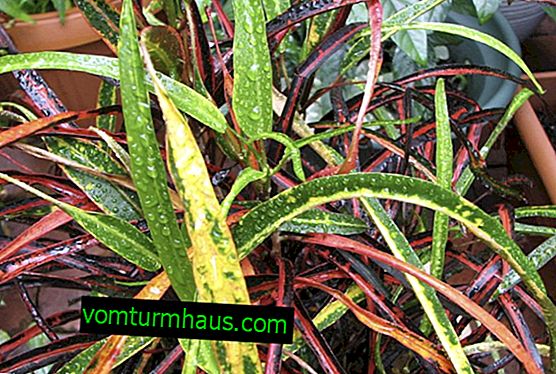
- Excellence (Excellent): the leaves resemble oak in shape, the color is the interweaving of spots and stripes of green and yellow hues, in the lower part they can be burgundy;
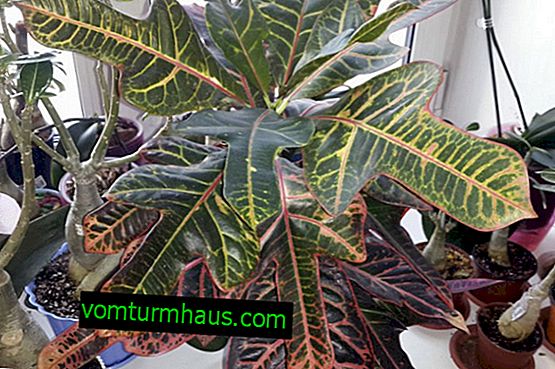
- Petra (Petra): leaves are oval, pointed or lobed, painted yellow along the edges and have yellow mottling in the center. The plant itself branches well;
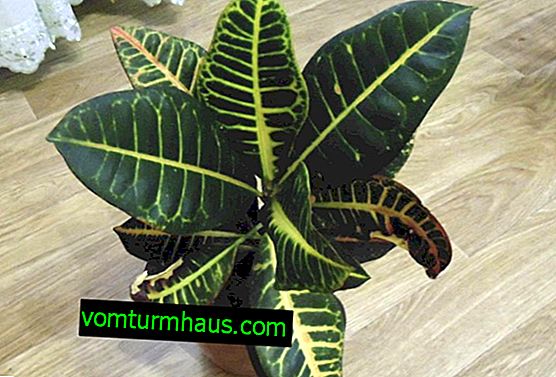
- Disraeli (Disraeli): leaves are lanceolate, two-tone - in the lower part are green, in the upper are burgundy;

- Splashes of champagne (Splashes of champagne): narrow leaves, green color with a small yellow spot;

- Mammi (Mammi): differs in a great variety of both the shape of the sheet plate (elongated, curled, wavy), and its color;

- Tamara (Tamara): a light border in the form of spots on medium-sized leaflets;
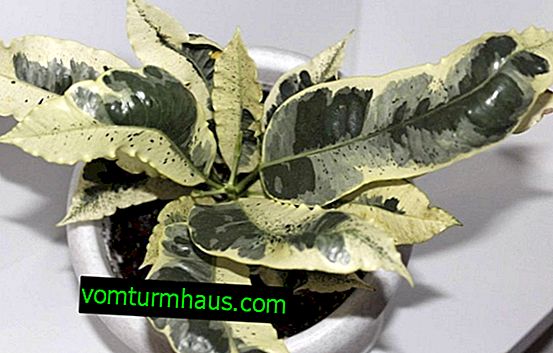
- Nervia (Nerve): jagged edges of long leaves with bright multi-colored;
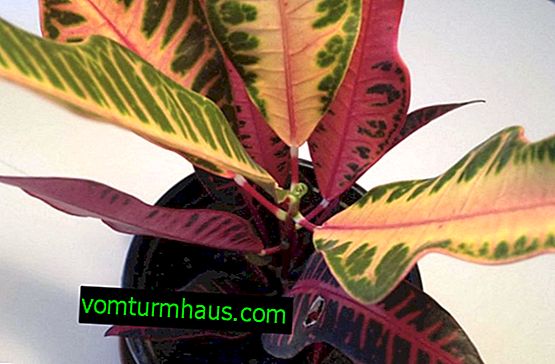
- Gold sun: Gold leaves are oblong, narrow at the base, the plant itself is quite large and spreading;
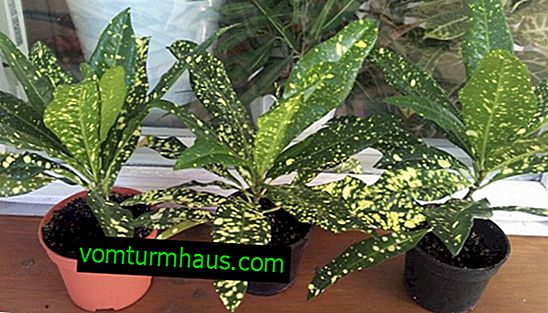
- dragon (draco): the American variety of croton, the main value of which is a very valuable red resin, widely used in medicine and the chemical industry;

- prickly (echinocarpus): a variety very similar to a dragon, characterized by the presence of thorns in the fruit box;
- Cascarolla (Eluteria): another variety of medicinal croton, is also one of the few varieties whose flowers look very decorative and, in addition, have a great aroma (the word "cascarolla" is translated as "bark", this name was given to the variety because it is his bark that has numerous medicinal properties);
- laxative (tiglium): the leaf plate is green, appreciated for the oil contained in the seeds and having a pronounced laxative effect;
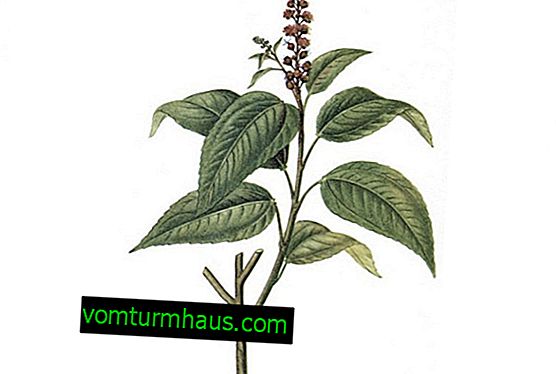
- Norma : leaves are large, at first yellow-green, red and green as they form;
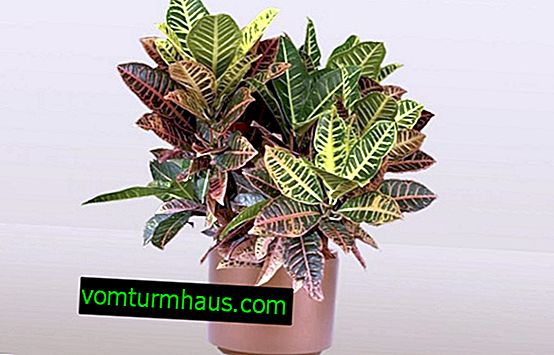
- Baron J. De Rothschild: different brightness and variety of colors, which may include orange, pink, yellow and green colors in different shades;
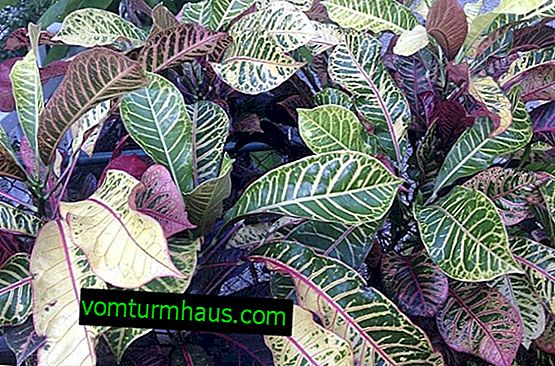
- Gold Star : leaves are long and narrow, connecting into rosettes, similar to stars, the color is green with yellow mottling;
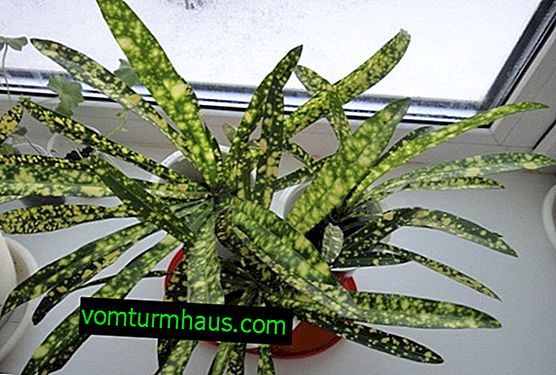
- Apple leaf (Appleleaf): different red fringing on the foliage;
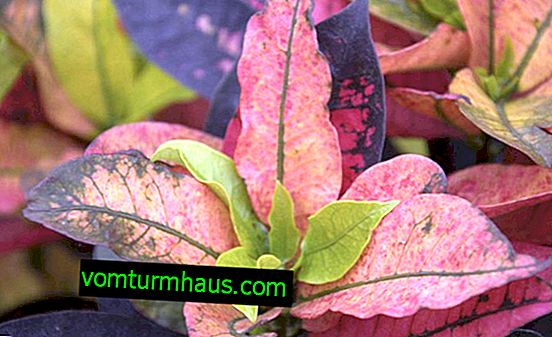
- Gold Moon (Gold Moon): the leaves are decorated with yellow stripes.

What conditions do you need to create at home
There is a version that it is the non-standard coloring of the codium leaves that determines its capriciousness. The lack of green in the terrestrial organs of the flower complicates the process of photosynthesis, which, as you know, allows you to provide the plant with the energy it needs. Therefore, in order for the croton to feel comfortable, it is so important to create the most favorable conditions for him, otherwise the flower may not endure the struggle for survival.
Did you know? In 1950, in the US state of Florida, a special croton nursery was opened, in which you can see more than five hundred different varieties of this plant.
Seat selection

- He loves heat, but does not tolerate dry air, so it can not be placed near heating appliances;
- photophilous, but in direct sunlight receives burns and often discards foliage;
- absolutely not adapted to sudden changes in temperature, and from the slightest draft can die.
Temperature and humidity
Croton loves heat, but the problem is that in city apartments, both in the summer and during the heating season, the hot air is too dry, so the optimum temperature conditions for the plant are considered to be between +20 and +22 ºC, and the permissible maximum is at +28 ° C. In winter, these indicators are best maintained at the level of + 18 ... + 19 ° С. It is also important that the fluctuations between daytime and nighttime temperatures do not exceed two to three degrees.

In addition to moisturizing the air, an integral part of codium care is the regular removal of dust from the leaf plates, otherwise the already complicated photosynthesis process may slow down even more. Periodically, the plant can be bathed in the shower, protecting the surface of the earth from the ingress of excess water.
How to care at home
It is noticed that the biggest problems with codium arise immediately after its acquisition, and even in the case when all the conditions seem to be created for the plant. You should not worry about this: if the care is organized correctly, after a while the flower will adapt to a new place and come to life.
Important! To facilitate the adaptation process, the plant brought from the store should be immediately watered and left for a week with a transparent film in which the flower was packaged. The microclimate and humidity inside it minimize the stress experienced by the croton as a result of the move. In the future, the state of the plant will directly depend on competent care, including, first of all, watering, top dressing, pruning and transplanting.
Watering
Like any indoor flower, codium does not tolerate stagnation of water in the pot, but, unlike most other plants, even a slight and short-term drying of the substrate can be fatal for it, so sufficient, but not excessive watering is an essential component of caring for croton. The frequency of the procedure depends on the temperature in the room and the season: in summer, watering should be more plentiful, in the off-season and in winter - moderate.

Important! Given the increased requirements for soil moisture and the simultaneous rejection of water stagnation during transplantation, you need to lay a reliable drainage layer in the pot. Water for irrigation should be used soft and slightly warmed up. Along with moistening the substrate, it is also worth spraying the plant itself.
Top dressing
So that the soil in the pot always remains nutritious and fertile, periodically, fertilizers must be applied to it - both organic and mineral. But too often this should not be done, since an excess of active substances can harm the plant. In the period from February to October, it is enough to feed once or twice a month, for the winter this process can be stopped.

- “Blank sheet” (NPK Stimulus);
- "Master Agro";
- "Planton Z";
- Royal mix crystal spray
- “Quitofor Stimulus”;
- "Proventus";
- "Rost Master";
- "Rost Smaragd";
- "Agrecol" and others.
Pruning
Another common mistake in caring for a croton is to ignore events such as pruning. With proper crown formation, the codium gets more space, suffers less from soil depletion and lack of energy, and also looks more attractive.
Pruning, in addition, can stimulate plant awakening after a winter dormant period, increase the number of side shoots, give the bush the desired shape and even treat a diseased flower by removing damaged stems and leaves.
The step-by-step cropping procedure looks like this:
- A sharp knife, secateurs or scissors are thoroughly wiped with alcohol and dried.
- Shoots selected for removal (diseased, broken, too long or old), as well as, if desired, flower buds are cut in one motion, so as not to cause unnecessary suffering to the plant.
- The place of cut is treated with chopped charcoal or fungicide for disinfection.

Transfer
The capricious croton painfully transfers the transplant, so even young plants are moved to a new pot no more than once every 2-3 years, as for adults, this period can be easily doubled. It is best to use the transshipment method for this purpose, transferring the flower to a larger flowerpot with an earthen lump, without exposing the roots. Partial renewal of the soil replaces the annual transplant: the topsoil is removed from the pot and replaced with a fresh substrate.

Important! Choosing the size of the pot, you need to consider that the growth rate of different types of codeium is not the same: the larger the leaf plate, the faster it grows. When transplanting codium, you can use a ready-made substrate for ornamental-deciduous plants, remembering that croton needs a light and nutritious, slightly acidic (pH 5.5 level) soil rich in humus. For self-preparation of the soil mixture, leaf and turf soil, sand, peat, humus or compost, as well as sphagnum and a small amount of charcoal are used. Small-sized varieties of croton grow well in a mixture of peat, compost and sand, without adding land as such.
How to propagate
For all its capriciousness, croton is very easily propagated by rooting of cuttings. A little less commonly used is the seed method of producing new plants.
Cuttings
For rooting, it is best to use not young shoots, but older branches, partially (but not completely) stiffened, since they are less prone to decay.

- You need to cut the stalk at a right angle at a height of 10-15 cm from the top. One to three buds must be present on the shoot.
- The lower leaves from the shoot should be cut off, the milky juice that stands out from the wounds should be thoroughly washed off. The remaining leaves, if they are large, can be carefully folded with a tube and bandaged to better preserve moisture.
- Then, it is desirable to incubate the cuttings for 24 hours in a solution with activated charcoal or a growth stimulant (preparations such as Kornevin, Heteroauxin, Radifarma, Charkor).
- After this, the shoot is placed in a mixture of sand and peat and put in an impromptu greenhouse for rooting. The rooting place should not be very light, but warm enough (+ 23 ... + 25 ºC), while it is desirable that the heat source is not from above, but from below, so it’s easiest to install a container with cuttings on the window sill of the battery.
Further care of the cuttings, lasting from one to one and a half months, consists in their regular ventilation and spraying, and it is recommended to add aloe juice to the water as a stimulant. When young plants start new shoots, they are immediately transplanted into separate pots with the usual soil mixture for croton.
Seeds
Before planting, the seeds of codium should be placed in hot water for 30 minutes, and then soaked for 24 hours in water with the addition of growth stimulants.

- Seeds are laid on the surface of a previously prepared substrate (sand and peat) and sprinkled on top with a thin layer of the same mixture up to 10 mm. The container is tightened with a film and placed in conditions similar to those described above for rooting cuttings. Shoots should appear in about two weeks.
- After this, the film must be started to shoot, first for a short time, then this period gradually increases so that the growing shoots gradually get used to the open air.
- After removing the film, the sprouts are watered and sprayed, and when they form three real leaves, they are transplanted into separate pots.
Important! The seed method of propagation of codium, unlike the vegetative one, does not guarantee the preservation of the signs of the mother in the new plant. Эта проблема актуальна для всех гибридных форм. Отсутствие яркой раскраски листов на молодых растениях не свидетельствует о потере декоративных качеств кротона: такова особенность этого цветка, необычные оттенки его листвы появляются с возрастом, причём позже всего это происходит с розовыми и красными цветами.

Growing difficulties
Все трудности, возникающие при содержании кротона, так или иначе связаны с ошибками цветовода. В чём именно состоит проблема, можно понять по реакции растения. For example:
- опадающие листья свидетельствуют о нарушении температурного режима (переохлаждение, сквозняк, перепад температур). Нужно, однако, иметь в виду, что сезонное сбрасывание листвы, особенно нижней и более старой её части, для кодиеума является нормой;
- отсутствие или исчезновение яркой раскраски — следствие недостатка освещения либо избытка азотных удобрений;
- мелкие и деформированные листья, напротив, говорят о том, что растение нужно подкормить;
- коричневые пятна на листовой пластине возникают, если цветок находится под воздействием прямых солнечных лучей, но если потемнение располагается по краям листа, это может свидетельствовать о переохлаждении;
- подсыхающие кончики листьев — верный признак недостаточной влажности воздуха. Если проблему не решить, листва начнёт опадать;
- чёрный налёт на тканях является симптомом грибковой болезни, именуемой чернью или сажистым грибом. Развитию инфекции способствует застой воды в почве. Лечится удалением поражённых участков и использованием фунгицидов, содержащих медь («Строби», «Скор», «Флинт», «Хорус», «Дитан М-45» и других).

Home value
Эзотерики приписывают кротону очень сильную энергетику, которая способна даже изменить атмосферу в доме.
Did you know? Кодиеум считают растением-вампиром, которое с удовольствием питается жизненными силами домочадцев, поэтому слабым, пожилым и нездоровым людям, особенно страдающим бессонницей, такой цветок лучше не заводить. В то же время сильных и уверенных в себе людей кротон сделает ещё более успешными. Этот цветок отлично помогает собраться с мыслями, поверить в свои возможности, повысить самооценку, поставить перед собой цель и следовать ей, не отступая. Также кодиеум отлично гармонирует с натурами творческими и независимыми, а унылым пессимистам помогает посмотреть на мир более позитивно.

Принимая во внимание все описанные свойства кодиеума, можно составить список тех, кому это растение подходит, а кому, напротив, заводить его нежелательно:
| Образ жизни и свойства характера, с которыми кротон гармонирует | Образ жизни и свойства характера, с которыми кротон конфликтует |
| любовь к порядку | недисциплинированность, хаос в мыслях и делах |
| флегматичность, уверенность в себе | склонность к истерикам |
| проблемы с коммуникацией и подбором аргументов в споре | повышенная разговорчивость (усилится ещё больше) |
| неумение заставить себя выполнить намеченные планы | трудоголизм (требуется другое растение, способствующее расслаблению) |
| креативность, творческая профессия | спонтанность в принятии решений |
Кротон — очень красивое декоративно-лиственное растение, нуждающееся в создании условий, обеспечить которые в обычной городской квартире довольно сложно. Однако, найдя правильный баланс в освещении и обеспечив цветку регулярный полив, а также максимальную влажность воздуха, при помощи этого удивительного представителя семейства Молочайные можно превратить своё жилище в настоящий тропический сад.























